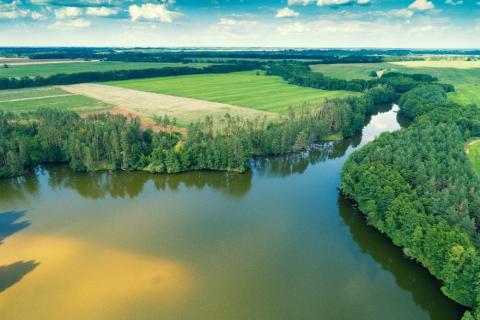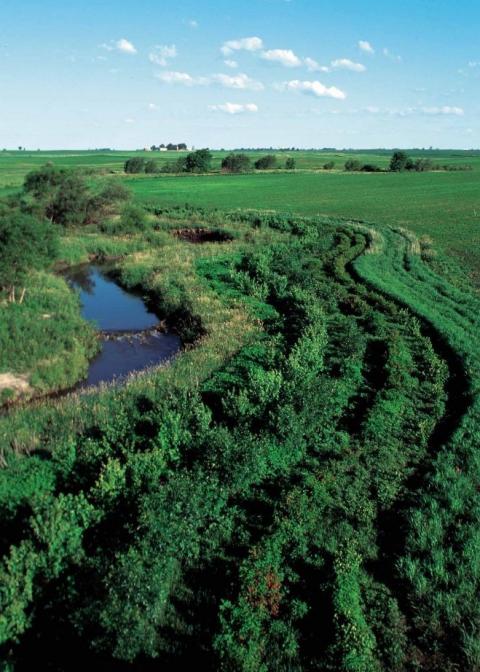28 August 2019
Dr William Stiles: IBERS, Aberystwyth University.
Take home messages:
- Riparian buffer strips are zones of permanent or semi-permanent vegetation which line the banks of freshwater systems, acting as a barrier between fields and neighbouring watercourses, reducing the effect of agricultural pollution.
- Establishing buffer strips can simultaneously increase tree or woody vegetation cover on farms, necessary for climate change mitigation, and reduce the potential for agricultural pollution.
- It is possible to use buffer strips to cultivate alternative products such as bioenergy crops or fruit producing species.
In recent years the impact of pollution on freshwater ecosystems from agricultural activities has been recognised as a major hazard for freshwater biodiversity and for the quality of surface and ground water reserves. A key challenge facing agriculture is how to reduce the impact of nutrient pollution generated by agricultural activities, particularly in the case of non-point source or diffuse pollution. In such situations the exact origin of pollution can be difficult to isolate and therefore difficult to manage. Diffuse pollution typically originates from a field or series of fields along a river corridor, making it a landscape-scale issue.
Riparian buffer strips are corridors of vegetation which flank the sides of freshwater systems such as rivers and streams and provide a barrier between field systems and freshwater systems. Vegetation buffer strips are a common component of strategies that aim to reduce the transfer of sediment, nutrients, and pesticides into freshwater ecosystems. Buffer strips can reduce the potential for nutrient transfer into freshwater systems through direct interception, uptake and utilisation of nutrients, or through supporting environmental conditions which promote exclusion through chemical transformations, such as denitrification. Large woody vegetation buffer strips can also act to stabilise riverbanks, both by reducing the potential for river erosion directly and by restricting livestock access, which limits trampling damage.
However, in many scenarios the width of buffer strips is set arbitrarily as a result of what is politically acceptable, or on the basis of what is assumed to be acceptable to farming professionals, in order to avoid conflict or lack of uptake. This approach is severely floored and results in a system which is neither effective, nor satisfying to any one party.
Benefits of implementing buffer strips
The beneficial effects associated with riparian buffer strips are varied and controversial. The degree of benefit likely to be derived from any buffer strip planted may depend on numerous variables including the width of the strip, soil type and characteristics, and the vegetation type planted. In addition, the amount and type of nutrients that are being intercepted may well affect efficacy. Buffer strips have been shown to be highly effective for reducing sediment transfer into aquatic ecosystems, which can also reduce nutrient
transfer where nutrients remain bound to soil particles. The presence of buffer strips can also help to maintain habitat quality for aquatic ecosystems. Water temperature has been shown to be lower where buffer strip vegetation was present, particularly where the vegetation coverage along the river bank was continuous and sufficiently tall to cast shade. Lower water temperature has been correlated with the abundance of certain fish species, notably salmonids.
Buffer strips can be composed of different types of vegetation, from grass or other herbaceous plants to large woody vegetation, such as trees. The reasons to choose between vegetation types are varied, but essentially the key factor is degree of management input versus usage. For instance, tree cover is the most stable in the long term requiring the least amount of active management, yet herbaceous or grassy
vegetation could also be included in a management rotation (i.e. low frequency hay or silage harvesting). In Wales where the majority of agricultural land is pasture, grass or herbaceous buffers could be considered the easiest to implement, as the only intervention required would be restricted access for stock to areas of the field along river banks (of an appropriate buffer width, see below) and similar restrictions of area where fertiliser is spread. Alternatively, developing buffer strips presents an opportunity to diversify farm crop options, by growing material for biofuels (timber, miscanthus) or species which yield fruit.
Strip width and design
Buffer strips composed of either trees or herbaceous vegetation can be effective in terms of nitrogen (N) removal, but there is some ambiguity with regard to which variety of vegetation is consistently better. One study demonstrated that tree buffers performed better in winter months than grass buffers, particularly for nitrate retention, but this effect is not consistent across studies. This particular study indicated that the benefit is likely to be derived from enhancement to the soil microbial community from the presence of trees, through introduction of carbon to the soil microbial biomass, which influenced N dynamics in the soil. It has been suggested that the optimum design is a mixed system, which uses a narrow strip of grass at the upland edge to trap suspended particulates and phosphorus (P), followed by a wider woody-biomass zone to trap N. A three tier system, utilising grass strips, juvenile trees or brush, and high canopy wood may offer even greater potential as the first two vegetation zones can be harvested for the purposes of bioenergy production, whilst still maintaining an adequate buffer zone.
Buffer strip effectiveness can be expected to be dependent on strip width and site specific characteristics including hydrology. No minimum buffer width has been identified here that is universal for the removal of sediment, P or N, with considerable uncertainty identified for each. What does vary is the degree of efficacy. For instance, one review of the evidence showed that the degree of effectiveness for the removal of sediment was between 30-90% for one metre wide buffers, between 55-90% for three metre wide buffers, and between 58-95% for six metre wide buffers. For the removal of P, buffers one to three metres wide were between 30-85% effective, and buffers 15 metres wide between 70-85% effective. For N, buffer widths of five metres can remove around 50%, which rises to 75% for buffers greater than 25 metres in width. The degree of variation in effectiveness demonstrates the difference potentially present across diverse sites. Thus, for the studies considered in this analysis, in order to be comprehensively effective regardless of type of pollutant or location, vegetation buffer strips greater than 30 metres in width appear to have the greatest potential.
Future Land management
The size of buffer strip necessary in order to be effective may be controversial, bordering on unpalatable for some farming enterprises. Nevertheless, there is a growing need to limit the transference of nutrients from farm systems into freshwater systems. It is entirely plausible that the need to limit impact may in future be viewed as greater than the need to produce food in these freshwater-marginal areas. In addition, under future NVZ legislation and the potential penalties associated with non-compliance, setting aside land in the vicinity of freshwater systems, of the scale necessary to act as a sufficient buffer zone, may prove the more cost effective option.
With this in mind, it is sensible to start considering this management style as an opportunity rather than penalty or inconvenience. It is currently expected that agricultural subsidy in Wales and the UK is likely to switch to a system which values the delivery of ‘public goods’, which are services provided by agriculture that benefit society. In this instance, components that are likely to play key roles will be the provision of biodiversity or carbon storage and sequestration. One way to increase this provision on farms is to increase the presence of trees and habitat opportunities. In this management system, riparian buffer strips present a potential ‘win-win’. Simultaneously reducing the impact of agricultural pollution (and the liability this potentially represents to farm businesses) whilst increasing the provision of woody biomass for carbon sequestration and habitat provision for biodiversity.
Furthermore, systems which utilise this woody biomass for the production of sustainable fuel, to be sold or utilised through Combined Heat and Power (CHP) within farm-systems, the production of timber, or which aim to plant fruit bearing tree species to offer alternative crops, will add an additional opportunity or advantage to farm businesses.
Summary
The establishment of even narrow vegetation buffer strips (<3 metres) alongside watercourses in agricultural landscapes, will reduce some of the impact of agricultural pollution and will add benefit in terms of riverbank stability and increased carbon sequestration in woody biomass, where trees are utilised as a buffer. However, in general terms, to significantly reduce this impact to around or near to zero, requires buffer strips of significantly greater width. The evidence reviewed here suggests that aiming for a buffer strip width in the region of 30 metres wide should, in most scenarios, be an effective strategy.
Whilst this is a potentially sizeable portion of land for farmers to set aside from production, this may become necessary in order to limit the impact of agriculture on freshwater ecosystems, which is an area of growing concern. In addition, this action could also be considered an opportunity to increase woody biomass and tree cover within Welsh farming systems, which currently have low tree cover rates, and to potentially instigate an alternative production opportunity, such as the cultivation of biomass for solid fuel or biofuel markets. In the future, should government subsidy shift towards a payment system predicated on the delivery of public goods, then this management system could present an opportunity to increase tree cover on Welsh farms, whilst simultaneously reducing the potential for pollution, actions which are likely to have a value in subsidy terms.
Click here to view a PDF version of the article.



